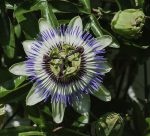
Also known as bluecrown passionflower and common passion flower, this vigorous vine is native to South America from Bolivia to Brazil and northern Argentina. It is a member of the Passifloraceae, a family of 750 species of mostly tropical trees, shrubs and vines and is evergreen in the tropics but deciduous in colder areas. The plants grow quickly to 10-40′ and have green to brown hairless stems with coiled green tendrils 2-4″ long at the base of the leaves. The shiny, hairless, green leaves are 3-6″ long and are palmately lobed usually with 5 lobes but 3,7, or 9 lobes are possible. From early summer to early fall, solitary saucer-shaped flowers appear on long stalks. Each flower is up to 4″ wide and has 10 rounded tepals ( petals and sepals) that are bluish white and surround a corona of blue, white and brown filaments. Three purple styles and 5 greenish-yellow stamens occupy the center of the flower. The fruit is a 1-3″ long berry that is at first green but matures to yellow or orange by fall. It is partially hollow inside and has a small amount of dark red pulp with a large number of seeds. Although the fruit is edible it is not tasty. Photo Credit Franz-van-Duns-Wikipedia.
In the 16th century the Jesuits landed in South America and found the natives there cultivating the blue passionflower, Passiflora caerulea, and eating its flesy fruits. They named the plant Flor de las cinco llagas, Flower of the Five Wounds, and thought that its floral organs symbolized The Passion of Christ. The 10 tepals represent 10 apostles, rather than the more usual 12 because Peter denied his Lord and Judas betrayed Him. The corona symbolizes the crown of thorns, the 5 stamens the 5 wounds, the ovary the hammer, and the 3 styles the 3 nails. A similar passionflower, P. incarnata, is hardier and native to the US and is considered by some to be a better choice for a Mary Garden.
Blue passionflower likes full sun to partial shade and average, medium moist, well-drained soil in USDA Hardiness Zones 7-9. Plants need good air circulation to control fungal diseases in humid conditions and should be watered deeply but infrequently to encourage a deep root system. Prune before new growth begins by removing some stems at ground level but alway leave some greenery on the plant. Pinch tips after flowering to encourage bushiness and fertilize sparingly so as not to encourage foliage at the expense of flowers. Numerous fungi may damage the plant and butterfly larvae may devour the foliage. Propagation is by seed, stem cuttings in spring, layering in late summer. Blue passionflower gives a tropical look to gardens and greenhouses. With its showy blooms it is a good choice for walls, fences, arbors, and containers and will not cause damage because it climbs by tendrils. Can become invasive.
The genus name, Passiflora, comes from the Latin words passio meaing suffering, and flos meaning flower and refers to the suffering of Christ because the flower is symbolically associated with the crucifixion. The specific epithet, caeruleae, is the Latin word meaning dark blue.